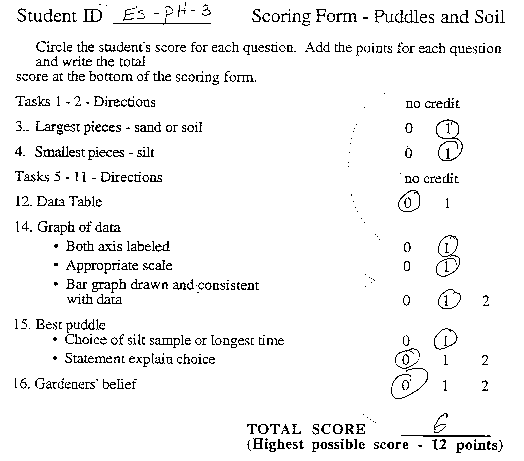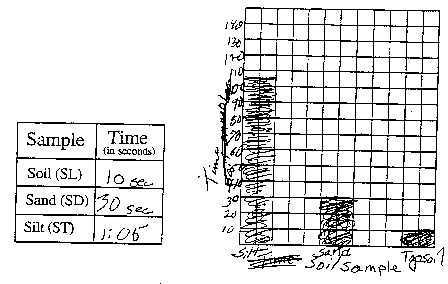Grade 5-8 Performance Task
Contributed by: New York State Education Department (NYSED)
NYS Alternative Assessment in Science Project (1996)
Student #3

Task:
At this station, you will be determining which
of several soil samples produces puddles.
Materials:
- soil sample
- sand sample
- silt sample
- hand lens
- plastic bottle
- 10 mL graduate
- funnel
- filter paper
- spoon
- paper towels
- water container
- stop watch
Directions:
- Place a small amount of soil, sand, and silt on a paper
towel. Label them soil (SL), sand (SD) and silt (ST).
- Observe each sample with the hand lens and set them to the
side.
- Which sample has the largest pieces?

- Which sample has the smallest pieces?

- Place the funnel into the plastic bottle.
- Fold the filter paper and place a filter in each funnel.
Directions for folding: Fold paper in half, then in half again.
Open to form a cone with 3 quarters on one side and one on
the other (see diagram).

- Fill the filter paper with water to wet the filter paper.
As soon as the water flows out of the funnel, dump the water
back into the water container. The filter paper should stick
to the sides of the funnel without any air bubbles. Be sure
to let all the water drip through the filter before placing
the soil sample in it.
- Measure out 10 mL of water in the graduated cylinder.
- Put 2 spoonfuls of the soil sample (SL) into the west filter
paper and gently pack down the sample with the back of the
spoon.
- Pour 10 mL of water on top of the soil in the funnel.
- Time how long it takes for the 10 mL of water to disappear
into the soil.
- Record your time on the data table.
- Repeat steps #8-12 with each of the remaining samples (SD
& ST).
- Make a bar graph of your data using sample and time as your
variables. Label both axes.

- Which sample made the best puddle?

Using complete sentences, write a statement
explaining why you think this sample made the best puddle.

- Gardeners believe that the smaller soil particles are, the
more slowly water will travel through the soil. Based on your
results, use complete sentences to tell why you think they
are or are not correct.

|
|


